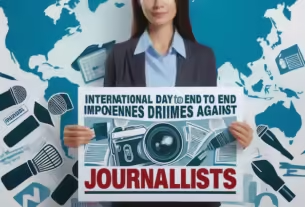What is Multimedia Journalism? – Multimedia journalism is a contemporary technique of storytelling that combines various styles of media—inclusive of text, audio, video, pictures, and interactive factors—to deliver news in a dynamic and tasty way.
As the media panorama has advanced with the upward thrust of virtual platforms, newshounds are no longer confined to the usage of just one medium like print or TV. Instead, they invent tales that spread throughout different types of media, supplying audiences with more than one method to consume records.
In practice, multimedia journalism entails integrating diverse content types to tell a complete tale. For example, an information article might consist of written content material, snapshots, embedded video interviews, audio clips, and interactive information visualizations.
This approach now not handiest complements the tale’s depth but also makes it extra available to unique audiences. Some humans choose to read articles, others interact more with video content, and some may additionally discover statistics in interactive codecs.
This form of journalism responds to the converting behavior of media consumers, who an increasing number of have interactions with information through smartphones, social media systems, and on-demand services.
According to the Pew Research Center, most U.S. Adults now get their information online, with many looking forward to richer, greater immersive studies. As a result, journalists need to be flexible, often generating multimedia content material independently or in collaboration with specialized groups.
Multimedia journalism is not just about reporting news; it is about engaging audiences in ways traditional media cannot. It makes stories more relatable, interactive, and immersive, and it plays a significant role in shaping public opinion. It allows reporters to craft fuller narratives, appealing to different audience preferences and providing a deeper exploration of current events, issues, and topics.
The Evolution of Journalism and the Rise of Multimedia
The evolution of journalism has been fashioned via technological improvements and shifting target audience behaviors. Traditionally, journalism has become tied to precise mediums—print for newspapers, audio for radio, and video for TV.
Each medium had barriers, and news became often eaten up in a linear, passive way. However, the upward thrust of the internet in the late Nineteen Nineties and early 2000s, observed by using the explosion of social media, basically modified how humans eat news.
Audiences no longer rely on an unmarried source for information. Instead, they get admission to content material through a couple of channels—websites, social media, and mobile apps—often concurrently. This shift in consumption habits brought about the rise of multimedia journalism, which blends textual content, video, audio, and interactive elements to create richer, more immersive news experiences.
People now expect dynamic, interactive content rather than static, one-dimensional formats. This shift became pushed by both the target audience calls for greater engaging content material and the technological advancements that made it viable.
Faster net speeds and digital equipment like video editing software, podcasting systems, and interactive records visualizations enabled reporters to experiment with and produce content material in various codecs.
As news organizations adapted, multimedia journalism became a powerful way to reach diverse audiences, offering them the freedom to choose how they consume information—whether through a written article, a video report, or interactive images. This emphasis on audience choice makes them feel empowered and catered to, enhancing their overall experience.

What Defines Multimedia Journalism?
Multimedia journalism is described by using its capability to integrate a couple of varieties of media—text, video, audio, pictures, and interactive content material—right into a single cohesive tale.
Unlike traditional journalism, which relies on one medium to carry facts, multimedia journalism blends special elements to offer an extra dynamic and layered storytelling revel in.
For example, a multimedia journalist overlaying an election could write an in-depth article with evaluation while additionally generating video interviews with the electorate, recording audio for a podcast, taking pictures key photos, and growing interactive visualizations of election outcomes.
This combination of media gives extra depth and nuance, as each format contributes a unique angle to the general narrative. At its center, multimedia journalism isn’t just about including greater content material however approximately improving the storytelling enjoy.
Each element—whether or not it’s an infographic, video clip, or interactive timeline—serves a specific motive, enriching the audience’s expertise of the subject. Moreover, it caters to extraordinary target market possibilities: a few may pick watching a video. In contrast, others opt for reading or interacting with statistics.
The flexibility of multimedia journalism is its greatest strength. It allows reporters to tell more comprehensive stories, meet audience demand for diverse content, and adapt to the rapidly changing digital landscape where consumers expect engaging, immersive experiences across platforms.
The prospects of multimedia journalism are promising, with advancements in technology and changing audience behaviors likely to further shape the field and its impact on news reporting.
The Key Elements of Multimedia Journalism
Multimedia journalism is built on numerous key factors that, while mixed, create a richer and more engaging storytelling experience. These factors encompass Text: The foundational component that provides context, details, and narrative shape.
Text conveys a lot of the records while being complemented via other media for engagement. Video: Adds a dynamic visible detail. Whether showing interviews or pictures of occasions, video content material brings immediacy and emotional impact to the story.
Audio: Useful for interviews, podcasts, or capturing the ecosystem of an area or event. Audio affords every other layer of depth, providing a more intimate connection with the audience. Photography: Still pictures seize moments in a way that neither text nor video can.
They spotlight key moments, human feelings, or visual information that may be ignored. Interactive Elements: Infographics, statistics visualizations, and clickable maps allow users to engage with content without delay.
These capabilities make complex facts greater accessible and allow customers to discover precise components of the tale. Together, those factors create a comprehensive and attractive storytelling layout, permitting audiences to interact with the tale in approaches that are high-quality in shaping their alternatives.

How Multimedia Journalism Works in Practice
In practice, multimedia journalism involves a collaborative and multi-layered approach to storytelling. Journalists work with various types of media—text, video, audio, photography, and interactive graphics—to create immersive stories for audiences.
Many modern newsrooms have specialized teams of videographers, graphic designers, and data analysts working with reporters to produce these stories. In smaller organizations or for freelancers, reporters may take on multiple roles, creating and editing content across various formats.
Successful examples of multimedia journalism stories include [insert examples here]. The procedure begins with story improvement, in which newshounds become aware of topics that lend themselves to multimedia treatment.
For example, a feature on climate exchange might include a written analysis. Video pictures of affected regions. Podcast interviews with scientists. Interactive maps showing environmental adjustments over time.
Next is content collecting, where journalists document interviews, shoot videos, take snapshots, and gather records. The venture ensures that every media type complements the others, providing precise insights and emotional intensity to the tale.
In the production phase, the content material is edited and refined. Text is written for readability, videos are edited for engagement, pix are curated to spotlight key moments, and interactive elements are designed to visualize facts.
Finally, all factors are incorporated into a seamless enjoyment, commonly hosted on a virtual platform, wherein audiences can interact with the tale primarily based on their possibilities.
The Impact of Multimedia Journalism on News Consumption
Multimedia journalism has appreciably modified how audiences consume news. In these days’s fast-paced virtual world, where attention spans are shorter and the call for for enticing content material is higher, multimedia journalism meets evolving target audience expectancies.
By combining text, video, audio, and interactive elements, it gives a greater flexible and immersive information experience. A key advantage is the potential to engage diverse audiences. Some humans choose to analyze in-intensity articles, at the same time as others gravitate in the direction of video content or interactive functions like infographics.
Multimedia journalism permits all these choices to coexist within a single story, making news intake more inclusive and accessible. Multimedia journalism also improves information retention. Studies show that combining extraordinary media kinds—which include visual and auditory—complements memory and information.
This multi-sensory engagement helps audiences hold close complex problems more correctly than text myself. Furthermore, multimedia journalism adapts to fashionable intake behavior. With the upward push of social media and cellular gadgets, multimedia stories are without difficulty shared across systems like Facebook and Twitter, expanding their attain and encouraging interaction.
Challenges and Limitations of Multimedia Journalism
Despite its many blessings, multimedia journalism faces challenges and obstacles. One most important troubles is resource depth. Producing multimedia content material calls for time, generation, and specialized competencies.
Smaller newsrooms or freelance newshounds may need more sources to compete with larger organizations that have committed multimedia groups. Another project is the technical information required to supply and control multimedia content.
Journalists are anticipated to have multi-disciplinary abilities, from writing and video manufacturing to information visualization. Balancing those obligations can be disturbing, particularly with tight closing dates.
Additionally, accessibility problems arise when multimedia content material requires high-velocity internet. In regions with limited infrastructure or for users with lower bandwidth, multimedia tales won’t load efficiently; proscribing gets the right of entry to the entire content material.
Finally, there’s an ability for target audience fragmentation. While multimedia journalism can interact with diverse audiences, some traditional readers may additionally feel beaten with the aid of too many media factors, leading to disengagement.
The Future of Multimedia Journalism
The future of multimedia journalism can be shaped through advancing technologies and converting target audience possibilities. Emerging gear like augmented truth (AR), digital fact (VR), and artificial intelligence (AI) will allow reporters to create extra immersive stories.
Imagine the use of AR to discover a catastrophe site really or VR to relive historical activities. This technology will redefine how information is instructed and experienced. Automation powered by using AI will streamline multimedia manufacturing, permitting reporters to awareness of storytelling.
At the same time, automatic equipment takes care of enhancing transcription and facts visualization. This will make multimedia journalism greater efficient and handy for smaller teams. Personalized information experiences may also develop.
Algorithms will tailor multimedia content based on user preferences, hobbies, and behaviors, ensuring that each audience member gets extra relevant and engaging information to enjoy.
Overall, the future of multimedia journalism promises more innovation, interactivity, and engagement, permitting reporters to conform to converting media landscapes and provide audiences with richer, greater customized news studies.
Conclusion
Multimedia journalism represents the destiny of storytelling in an increasingly more digital international. By mixing textual content, video, audio, images, and interactive factors, it gives a richer, greater enticing revel that meets the needs of contemporary audiences.
As media intake behavior evolves, multimedia journalism provides a flexible technique that caters to various alternatives—whether or not customers decide to study, watch, or engage with content without delay.
While challenges like useful resource obstacles and technical needs exist, improvements in technologies like augmented fact, virtual fact, and synthetic intelligence will continue to force innovation in this subject.
The future of multimedia journalism is brilliant, imparting new methods for journalists to tell immersive testimonies that inform, interact, and inspire. These changes must provide a more cohesive and well-rounded glide, beginning from the creation and finishing in the conclusion while addressing all elements of multimedia journalism effectively.
Frequently Asked Questions
What is multimedia journalism?
Multimedia journalism is a contemporary technique to information reporting that integrates numerous kinds of media—inclusive of text, audio, video, pictures, and interactive content—to create a greater dynamic and tasty storytelling. This type of journalism permits audiences to consume records via more than one format, improving the depth and accessibility of information testimonies.
What are the key features of multimedia journalism?
Multimedia journalism is defined by the integration of various media elements, along with textual content, video, audio, pictures, and interactive content material like infographics and information visualizations. These elements of paintings collectively provide a comprehensive and engaging narrative, permitting audiences to explore testimonies in more than one approach.
What are the advantages of multimedia journalism?
The primary advantages of multimedia journalism consist of extended target market engagement, more powerful communication of complex tales, and the ability to cater to various audience alternatives. By offering content material in multiple formats, such as video, interactive snapshots, or podcasts, multimedia journalism makes records more on hand and noteworthy.
What does a multimedia journalist do?
A multimedia journalist creates testimonies about the usage of a mixture of different media kinds. They would possibly write articles, shoot and edit motion pictures, report audio for podcasts, take pix, and design interactive elements like infographics. Multimedia journalists are professionals in diverse elements of media production to provide a richer storytelling enjoy.
How does multimedia journalism impact news consumption?
Multimedia journalism substantially enhances news intake by offering more interactive, immersive, and tasty content material. Audiences can choose how they engage with a tale—whether or not through video, audio, or textual content—which makes the information greater reachable and relevant, especially in the digital age.
What is the difference between broadcast journalism and multimedia journalism?
Broadcast journalism normally focuses on turning in information through traditional media consisting of tv and radio. In evaluation, multimedia journalism integrates quite a few virtual codecs, including textual content, video, audio, and interactive factors, to tell testimonies across a couple of structures, such as websites and social media.
Here is an interesting article: https://topalways.co.uk/exploring-the-different-types-of-news-reporting/


